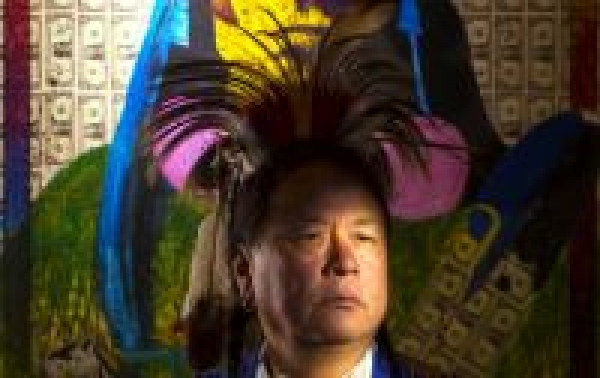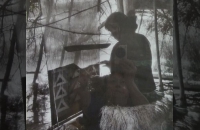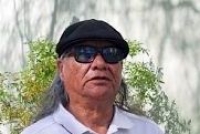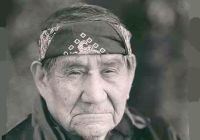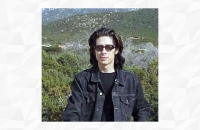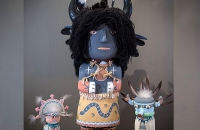STAN NATCHEZ
(Shoshone-Tataviam or Paiute b. 1954 – present)
Artist Stan Natchez took a circuitous route to his successful career as a full-time artist. His father, an intellectual, authored a book on the connections between Jungian and Native American symbolism and Natchez himself earned a bachelor's and master's degree before teaching humanities for 10 years at a prep school, then serving as an editor at Native Peoples Magazine. Always a creative child while growing up in Los Angeles, it was his participation in Native American dances that led him to painting.
“In the white man’s world, if you want to get an education, you go to college,” Natchez explains. “In the Indian way, if you want to get knowledge, you go through ceremonies. I am a California Indian (Tataviam, “the people who face the sun”) and all our ceremonies are gone. But I was fortunate enough to travel throughout the United States and meet people who lived in tribes that had ceremonies and invited me in.” Performing traditional Native American dances throughout Europe and the U.S., Natchez developed a fine eye for both color and composition from the beadwork he created for his regalia. By learning from elders of many tribes during these travels, he gives credit to this artistic medium for building in him a stronger sense of cultural self-esteem.
Having earned a Bachelor of Science degree at the University of Southern Colorado (Education) and a Master of Fine Arts (Curriculum) at Arizona State University, Stan Natchez has always been an educator, and a student of the world. Former Humanities Department Chairman at Arizona's Orme School, he has also taught art in several public schools. Currently, he is Editorial Advisor and Education Coordinator for the Native Peoples Magazine. In addition to being an artist, Mr. Natchez is a legal advocate for the Native American community.
Performing traditional Native American dances throughout Europe and the U.S., Natchez developed a fine eye for both color and composition from the beadwork he created for his regalia. By learning from elders of many tribes during these travels, he gives credit to this artistic medium for building in him a stronger sense of cultural self-esteem. For many years, Mr. Natchez participated in the Sun Dance in South Dakota. This ceremony dates back at least 300 years. Dancers circle a tree trunk and pray for spiritual rebirth and earth regeneration.
"I feel fortunate for having been raised in the city because of the perspective it gave me on modern life," Natchez observes. "However, without an awareness of our traditional heritage, we as Native Americans have no identity. By taking the best of both worlds, the modern and the traditional, we are better able to find balance in our lives."
The philosophies and techniques of these two worlds have allowed Natchez to achieve a complex harmony in his work - with a distinctive Neo-Pop style. Inspired by Andy Warhol, Jasper Johns and other Pop artists, his paintings exude the power of color and familiar objects. His unique and dramatic mixed-media paintings may incorporate a range of items from beadwork to bottle caps into their design. Images are conveyed with the two-dimensional look of Native American "ledger art" even as the artist's subjects ask viewers to look deeper at that which is represented. By overlaying many of these images over actual U.S. currency the representation of ideas grows more compellingly complex. "When I paint the dollar bill," the artist explains, "I'm saying that the dollar bill is a symbol of the world we live in. When you go to the store, what do you need to buy something? You need money, right? In the 1700s and 1800s Indians painted on deerskin, buffalo or elk hides. And if you wanted something, hides were your money. So the modern-day hide is the dollar bill."
Stan Natchez had an artistic epiphany when he interpreted a sheet of uncut dollar bills as ''the new buffalo hide'' and painted on it the image of a buffalo hunt. He soon expanded the idea to painting on pages from the bible and telephone books and on stock certificates and other documents. That cultural stamp, often involving money and the American Flag, is combined in his paintings with traditional Indian and landscape images.
Like many of his cohorts, Natchez takes on subjects with anger potential but portrays them with humor and a painterly finesse. When he was a child, his grandmother schooled him in the traditional beadwork that adorns dance costumes and taught him to hold bitterness and hatred as a disease.
In terms of his art, Natchez feels equally strongly about communicating contemporary Native American philosophy that has been purged of any romantic or stereotypical idealism. Instead, the viewer is exposed to traditional teaching and contemporary cultural doctrines.
As Natchez says, "I paint the life I live and so every painting I do is, in some way, a self-portrait. My art is about you and the way I respond. That is my experience...my experience is my art...and art is my life."
SOLO EXHIBITIONS INCLUDE:
Union Club, Frankfurt, Germany
Merrill Lynch, Munich, Germany
Spirit of Native America, Latin American Tour, American Indian Contemporary Arts
American West Gallery, Sun Valley, Idaho
First People’s Gallery, Minneapolis, Minnesota
Elaine Horwitch Galleries, Indian Market, Santa Fe, New Mexico
Visions of Native America, Senate Rotunda Room, Washington, DC
Roskilde Festival, Cultural Exchange and Art Show, Roskilde, Denmark
Cline Gallery, Santa Fe, New Mexico
Bischoff’s Gallery, Scottsdale, Arizona
Annual Show at Stan Natchez Studio Santa Fe, New Mexico
GROUP EXHIBITIONS & COLLECTIONS INCLUDE:
Native American Images, Raymond-James Financial Art Collection, Eckerd College
Metropolitan Art Institute, Washington, DC
Autry National Center, Los Angeles
Words Rockwell Museum of Art, Corning, NY
The Museum of the American Indian, New York
Southwest Museum, Los Angeles
Smithsonian: National Museum of the American Indian (Red Cloud Living in Two Worlds) 2003
PUBLICATIONS:
Whole Life Times
Focus/Santa Fe, January February March 2001
Santa Fe New Mexican
SPECIAL ACKNOWLEDGMENTS:
Selected artist for Parada del Sol poster, Scottsdale, Arizona 2006

